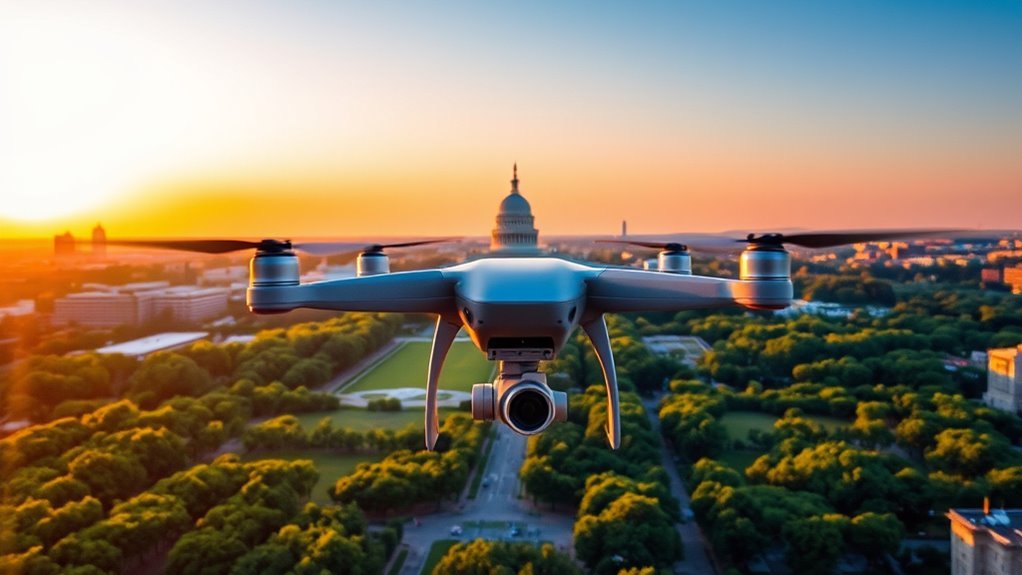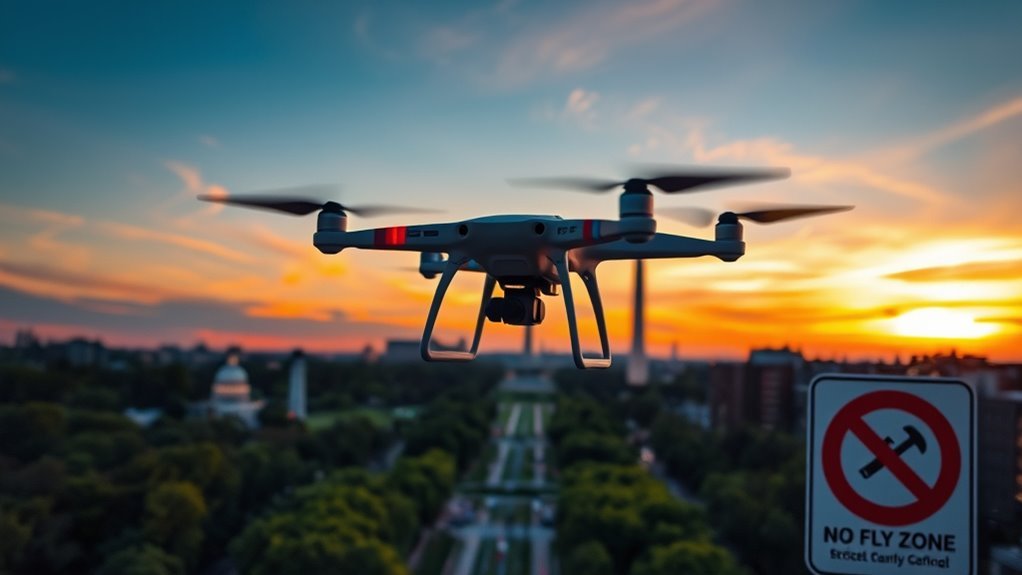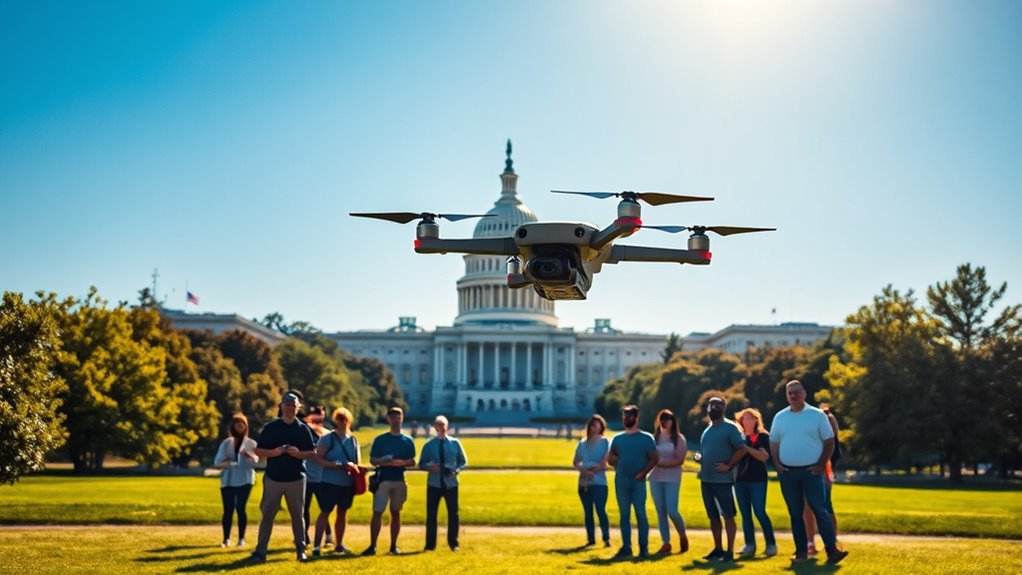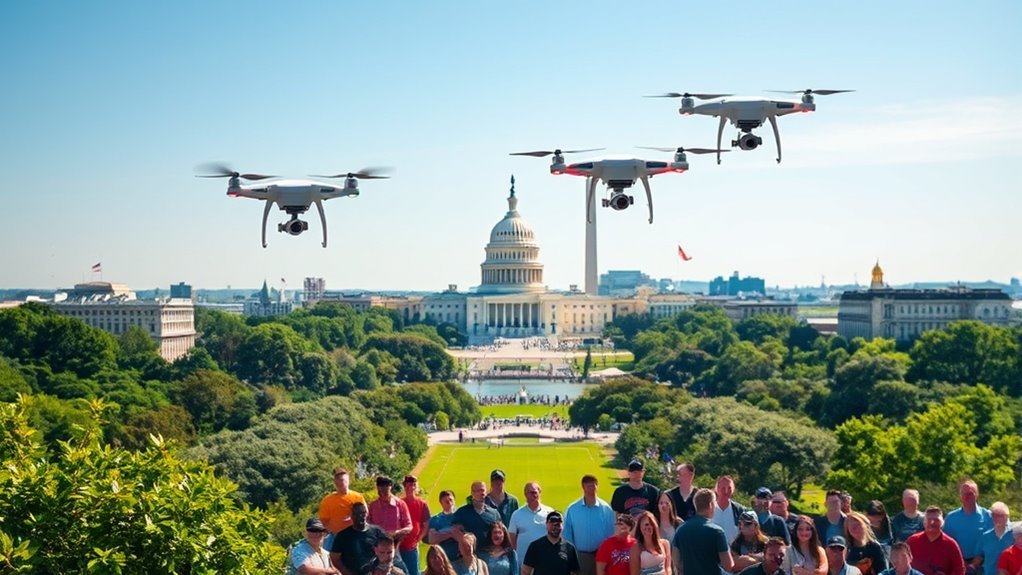To fly drones legally in Washington DC, you need to understand federal regulations and local laws. Register your drone if it weighs over 0.55 pounds, and always maintain visual line of sight while flying. Avoid no-fly zones like the National Mall and restricted areas around government buildings. Insurance is essential for liability protection. Staying compliant guarantees safety and enhances public perception of drones. Continue exploring to discover in-depth insights on each aspect of drone operation in DC.
Understanding Federal Regulations for Drone Use

Understanding the federal regulations governing drone use is essential for anyone looking to fly legally in Washington DC. The Federal Aviation Administration (FAA) oversees drone technology, ensuring safety and compliance within national airspace. To operate your drone, you must register it if it weighs more than 0.55 pounds. Additionally, you need to adhere to operational guidelines, such as maintaining visual line of sight and avoiding restricted airspace. Regulatory compliance not only safeguards your freedom to fly but also contributes to broader public safety and privacy concerns. Familiarizing yourself with these rules is fundamental to avoid potential fines or penalties, allowing you to enjoy the benefits of drone technology while respecting the legal framework governing its use.
Local Laws and Restrictions in Washington DC

While federal regulations set the baseline for drone operation, local laws in Washington DC impose additional restrictions that you must navigate. The city has unique regulations that often emphasize safety and privacy concerns, requiring you to stay informed. Local enforcement agencies actively monitor drone activity, so it’s essential to understand where you can and cannot fly. Areas like national parks and certain government buildings are off-limits, and flying over crowds is generally prohibited. Community awareness is significant; engaging with local drone groups can provide insights into nuances in the law. By respecting these local laws, you not only guarantee compliance but also contribute positively to the community, fostering an environment where drone enthusiasts can operate freely and responsibly.
Registering Your Drone: What You Need to Know

Maneuvering local regulations isn’t the only step in ensuring your drone operation is lawful; registering your drone is a fundamental requirement. The drone registration process is straightforward and vital for compliance. You’ll need to provide basic information about your drone, including its make, model, and serial number. Fortunately, online registration platforms simplify this task, allowing you to complete the process from the comfort of your home. The FAA mandates that all drones over 0.55 pounds must be registered, ensuring accountability and safety in the skies. By registering, you not only meet legal obligations but also gain a sense of freedom to fly responsibly. Embrace this essential step to enjoy your aerial adventures with peace of mind. Additionally, being aware of the potential legal penalties for failing to register your drone can prevent costly mistakes.
No-Fly Zones and Restricted Areas
When flying drones in Washington DC, it’s essential to understand the various no-fly zones and restricted areas. This includes specific restrictions around the National Mall, airspace classifications, and the proximity to government buildings. Familiarizing yourself with these regulations will help guarantee your drone operations remain legal and safe.
National Mall Restrictions
Although flying drones can offer stunning aerial views, the National Mall in Washington, DC, presents significant restrictions that you must navigate carefully. This iconic area, rich in history and culture, is heavily regulated to protect both the public and the monuments. As a drone enthusiast, you’ll need to be aware that the National Mall is designated as a no-fly zone, which prohibits drone photography without special permission. Violating these rules can result in fines or confiscation of your equipment. If you’re keen to capture the beauty of the Mall, consider seeking permits or exploring designated areas nearby where flying might be allowed. Staying informed and compliant is key to enjoying your aerial adventures while respecting the regulations in place.
Airspace Classifications
Maneuvering the skies above Washington, DC requires a solid understanding of airspace classifications, particularly when it comes to no-fly zones and restricted areas. Knowing the various airspace types is essential for responsible drone operation, especially in a densely populated area.
Here are key points to remember:
- Class B Airspace: Surrounds major airports; limited access.
- Class D Airspace: Surrounds smaller airports; requires communication with control towers.
- Prohibited Zones: Areas where drone flight is entirely forbidden.
- Restricted Areas: Flight is limited but may be allowed with special permission.
- Flying Altitude: Stay below 400 feet to avoid conflicts with manned aircraft.
Understanding these classifications guarantees you can enjoy your flight while respecting the law.
Government Buildings Proximity
Maneuvering the airspace near government buildings in Washington, DC, requires a keen awareness of strict regulations regarding no-fly zones and restricted areas. These zones are primarily established to enhance security and limit government surveillance, impacting your ability to engage in drone photography. You must avoid flying within a defined radius of key sites, such as the White House and Capitol Hill. Violating these restrictions can result in severe penalties, including fines or confiscation of your drone. To enjoy the freedom of capturing stunning aerial images while staying compliant, always check local regulations and airspace maps. Understanding these limitations not only protects your interests but also contributes to a safer environment for all. Stay informed, and you can navigate the skies responsibly.
Guidelines for Safe and Responsible Flying
When you consider flying drones in Washington DC, adhering to guidelines for safe and responsible flying is essential to guarantee both compliance with regulations and the safety of those around you. Practicing drone safety and flight etiquette is crucial. Here are some key points to remember:
- Always maintain visual line-of-sight with your drone.
- Avoid flying over crowds or congested areas.
- Respect no-fly zones, especially near government buildings.
- Be mindful of local wildlife and their habitats.
- Keep your drone within the specified altitude limits.
Privacy Considerations When Operating Drones
While flying drones can be an exhilarating experience, it’s essential to take into account the privacy implications that come with capturing aerial footage. When you operate a drone, you might inadvertently infringe on others’ privacy rights, especially in densely populated areas like Washington DC. Be mindful of where you’re flying and what you’re recording; data collection should never come at the expense of someone’s personal space. Always consider potential consequences, such as unwanted surveillance or data misuse. Respecting privacy isn’t just about following the law; it’s about fostering a culture of trust and freedom. By operating your drone responsibly, you can enjoy the thrill of flight without compromising the privacy of those around you.
Obtaining Necessary Permits and Permissions
Before you take to the skies with your drone in Washington DC, it’s crucial to understand the legal landscape surrounding permits and permissions. Steering through the permit application and the permission process can seem intimidating, but it guarantees you’re flying legally.
Here are key steps to reflect on:
- Research local regulations specific to Washington DC.
- Complete the necessary permit application accurately.
- Submit your application well in advance of your planned flight.
- Await confirmation and any additional requirements from authorities.
- Stay updated on any changes in drone laws or regulations.
Insurance Requirements for Drone Operators
When operating a drone in Washington DC, having the right insurance is essential for protecting yourself and your investment. You’ll need to understand the minimum coverage levels required by local regulations and consider your potential liability in case of accidents. Evaluating these aspects will help you navigate the complexities of drone operation safely and legally.
Importance of Insurance
Insurance serves as a critical safety net for drone operators in Washington DC, guaranteeing both compliance and protection. It’s essential for effective risk management, allowing you to focus on exploring the skies without constant worry. Understanding your coverage options is crucial, as it can shield you from potential liabilities. Here are some key reasons why insurance is important:
- Protects against damages to third parties
- Covers potential repair costs for your drone
- Guarantees compliance with local regulations
- Provides peace of mind while flying
- Enhances your credibility as a responsible operator
Minimum Coverage Levels
Understanding your insurance options is just the beginning; knowing the specific minimum coverage levels required for drone operators in Washington DC is equally important. To guarantee you’re compliant and protected, familiarize yourself with the following coverage requirements:
| Coverage Type | Minimum Coverage Level | Notes |
|---|---|---|
| Liability Insurance | $1,000,000 | Covers third-party damages |
| Property Damage | $100,000 | For damage to property |
| Personal Injury | $500,000 | Protects against bodily harm |
| Equipment Insurance | Varies | Covers loss/damage to your drone |
| Unmanned Aircraft Liability | $1,000,000 | Required for commercial use |
Knowing these minimum coverage levels helps you navigate your insurance options effectively, so you can fly freely and responsibly.
Liability Considerations
While it may seem straightforward, maneuvering liability considerations for drone operations in Washington DC requires a detailed understanding of the insurance landscape. To protect yourself against potential drone accidents, you need to take into account the following:
- General Liability Insurance: Covers bodily injury and property damage.
- Drone-Specific Insurance: Specifically tailored to drone operations.
- Liability Waivers: Important for reducing risk but not a substitute for insurance.
- Coverage Limits: Verify they meet or exceed local regulations.
- Policy Exclusions: Be aware of what’s not covered, like intentional damages.
Understanding these aspects not only safeguards your freedom to fly but also guarantees you’re prepared for any unforeseen incidents. Proper insurance can mitigate risks associated with liability waivers and drone accidents, letting you operate with confidence.
Resources for Staying Updated on Drone Regulations
How can you guarantee that you’re staying compliant with the ever-evolving drone regulations in Washington, DC? One of the best ways is to tap into reliable resources for drone news and regulation updates. Subscribe to the Federal Aviation Administration (FAA) newsletters and follow their official social media channels. They provide timely updates on any changes that might affect your flying experience. Also, consider joining local drone clubs or online forums where enthusiasts share insights and updates. Websites like Remote Pilot Association and DroneU are excellent for curated information and expert analysis. By actively engaging with these resources, you’ll not only ascertain compliance but also enjoy the freedom that responsible drone flying brings. Stay informed, stay compliant!
Frequently Asked Questions
Can I Fly Drones for Commercial Purposes in Washington DC?
Yes, you can fly drones for commercial purposes in Washington DC, but you’ll need to adhere to commercial drone regulations and obtain the necessary drone permit requirements. It’s essential to stay informed and compliant.
What Is the Maximum Altitude Allowed for Drone Flights?
When flying drones, you should be aware that altitude limits typically cap at 400 feet above ground level. Adhering to drone regulations is essential for safety and maintaining your freedom to operate in controlled airspace.
Are There Age Restrictions for Drone Operators in DC?
You might think age limits are restrictive, but they’re essential for ensuring operator responsibilities. In D.C., drone operators must be at least 13, fostering a responsible flying culture while allowing enthusiasts to explore their freedom.
Do I Need a License to Fly a Drone Recreationally?
You don’t need a license for recreational flying, but you must adhere to drone regulations. Familiarizing yourself with local laws guarantees you enjoy your freedom while flying responsibly and safely in designated areas.
Can I Use My Drone for Photography in Public Spaces?
You can use your drone for photography in public spaces, but you must adhere to drone regulations ensuring public safety. Always check local laws and guidelines to avoid potential fines or restrictions on your activities.

